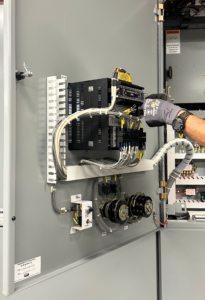Previously, we wrote about the need to replace aging electronic relays as they reach their end-of-life. Affected facility owners have an opportunity to choose from a wide variety of replacement alternatives. The new relay selection process can be daunting as the market is flooded with devices that offer a wide range of features. Because of the level of complexity, many owners hire third-party consultants to assist with selection, testing, and installation. As a consultant and testing firm, Hood Patterson & Dewar has guided many owners through this frequently problematic process.
One aspect of the relay replacement process that isn’t often discussed involves unknown existing issues in relay programming, wiring, and functionality. Many facilities don’t realize the protection they thought was in place was, in fact, missing, as there are copious issues surrounding functionality. In the examples below, these unfortunate conditions would have remained undiscovered but for the relay replacement project or a fault event with dire consequences.
Case Studies of Existing Relay Installations
- Prior to replacement, we investigated a site with a relay that was supposed to monitor a breaker’s status. The existing wiring and contacts were incorrect, meaning the relay could not determine the breaker’s status. We corrected the wiring and confirmed all required functionality as part of the relay replacement.
- We reviewed 20 sites for one client and only found two that had documentation of the existing power system coordination study and relay settings that matched the study. The rest of the facilities had random or default settings, no electrical testing stickers, maintenance records, or a one-line diagram. These conditions create a huge challenge when trying to replace or upgrade obsolete relays.
- At one data center, we performed a due diligence inspection and testing of the existing installation before the planned replacement. We found a number of relays with no visual indication that they were inoperative. The relays’ enabled LED was illuminated, signifying ‘relay in-service,’ but upon software trip simulation, the relays were found to be unresponsive. The facility was unaware of its compromised condition and that these relays provided no protection. Had there been a fault, the upstream device would have operated, unnecessarily de-energizing a much larger section of the facility. These relays have now been replaced, programmed, and tested, restoring the protection that should have been in place all along.
- One manufacturing plant assumed we could employ direct replacement relays in a simple retrofit project. We proceeded to inspect the existing relays and wiring. The overcurrent settings in the relays didn’t match the coordination study; furthermore, the relays’ outputs didn’t line up with the intended logic and wiring. No one on site had any explanation or knowledge of when and how this condition occurred. This simple project expanded into a new coordination study with new settings and retrofitted relays that were properly programmed and tested.
-

Relay retrofits should not be done on energized circuits because the facility is without protection during the upgrade.
An industrial plant was planning to replace its existing three single-phase relays on a medium voltage (MV) main breaker with a single three-phase relay. While reviewing the existing installation, we performed point-to-point wiring checks and found control power for the breaker trip circuit de-energized. The lack of trip circuit voltage left the relays unable to open the breaker during a fault condition. The facility was unaware of this issue and how long it had existed. This unfortunate condition would have remained undiscovered but for the relay replacement project.
Relays play a key role in your site’s electrical protection. Evaluation of the existing conditions and careful execution of the replacements are paramount to minimizing unnecessary risk, avoiding unplanned downtime, and having a circuit that is not properly protected, which could lead to equipment damage or personnel injury. Hiring a professional testing and consulting firm with knowledge of all the caveats involved in selecting, coordinating, testing, and installing these relays is vital for peace of mind and a successful project.


